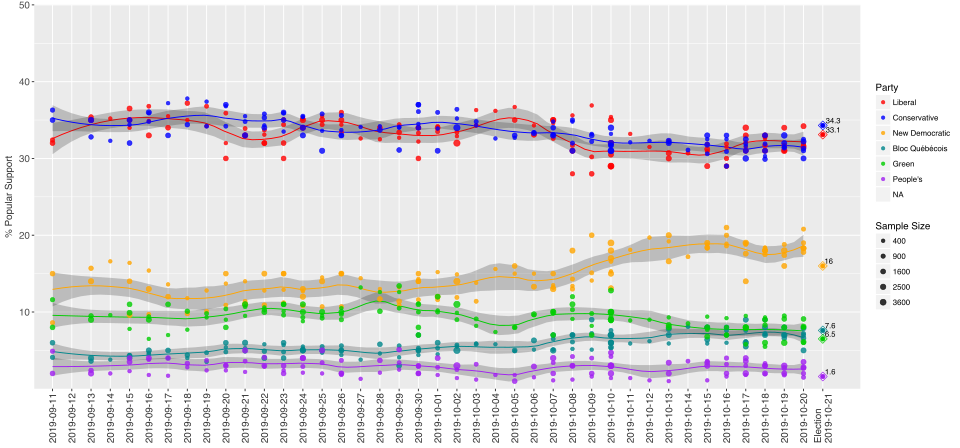The Base Pivot Necessary For Change
Do the Conservatives really need to pivot if they're polling at 40%? Yes. And no.
Well, that’s one way to start a campaign.
The Liberals and Conservatives both flirting around 40% - the Liberals above, the Conservatives below - and the New Democrats falling to levels not seen in my lifetime.
Much has been made about the Conservatives’ - and Pierre Poilievre’s - apparent failure to meet the moment we’re in. It’s one thing to go back to messaging that might’ve worked a few months ago - campaigning on axing the tax and rallying against what Poilievre refers to as a “globalist ideology.”
But at this moment in time, with US-Canada relations (and everything that branches off from it) becoming the ballot question, it begs the question:
Do the Conservatives need to pivot?
The Case Against A Pivot
It’s abundantly clear that the Liberals began this campaign with a clear advantage. They’re leading the polls - at the national level and in strategically-important regions - and many believe that they are the party that’s meeting the moment.
The vibe shift continues to move in their direction, and a series of shrewd moves by the Liberals in the first few days of the campaign seem to indicate that they not only believe they can win the election, but coalesce an even bigger tent of centrists and progressives to win a majority.
But this is a section on why the Conservatives don’t need to pivot!
You’re right. Polling data indicates that, if an election were held today, the Liberals would win a majority. However, there exist a number of scenarios where the Liberals win a majority and the Conservative seat count goes up.
Waning support for the New Democrats may be pushing a number of NDP seats into the Conservative column (looking at you, BC), but, should there be a time where the NDP manage to reverse the trend they’re on, we may be in a situation where they start to eat away at the Liberals.
This scenario, of course, relies more on the Liberals losing support to the NDP over the course of the campaign. If it does happen, it wouldn’t be the first time this century where the NDP gained at the expense of the Liberals in the second half of a campaign.
While there was a wavelet of support for the NDP in the closing days of the 2019 campaign, they seemingly took support from all parties:
There was another time where an NDP surge didn’t happen until the latter half of the campaign:
Of course, the circumstances of the 2011 election were the definition of lightning in a bottle - a fledgling Liberal Party, the Bloc on a downswing, and the NDP finding the right spark at the right time to begin their Orange Crush to Official Opposition.
After one week of this year’s campaign, it’s starting to become clear that the Conservatives may not be able to rely on an NDP rise to alleviate losses to the Liberals. There’s still time yet to come, though, and a lot can happen in four weeks.
It’s still possible for the Conservatives to win a plurality without a significant pivot. But it’ll rely more on the Liberals bleeding support back to the NDP (and the Bloc) more than it will the Conservative’s campaign strategy.
The Case For A Pivot
By now, you might have seen a few articles floating around the internet discussing infighting, conflicts, and disputes within the upper echelons of the Conservative campaign. It’s not unusual for articles like this to come out in order to light a fire under core campaign executives - hoping that a pivot comes sooner rather than later.
It’s clear that the ballot question has shifted from a referendum on Justin Trudeau to Canada-US relations, with affordability and the cost of living still looming large over everything. One could make the argument that the Conservatives won the 2024 general election. They led polls throughout the year. They ended the year on pace to win a record amount of seats.
People listened to what Pierre Poilievre was saying because, at a time when there was a perceived vacuum of leadership on the cost of living, he was hitting the notes Canadians wanted to hear. They met the moment for 2024.
Then everything changed.
In the hours and days following Mark Carney’s election as Liberal leader, it became clear that the Liberals were meeting the moment far better than the Conservatives. At a time when Canadians were looking for a unifying message of hope, it was the Liberals who picked up that mantle at a far greater rate than the Conservatives.
As we enter the second week of the campaign, it’s starting to become abundantly clear that Pierre Poilievre needs to refocus his strategy back towards the core ballot question in this election. However, there’s a delicate balance that must be maintained.
To reference two of Paul Wells’ Four Rules: The candidate in the best mood wins, and the candidate who auditions for the role of opposition leader will get the job.
At this stage of the campaign, it’s quite easy to place Mark Carney as the candidate in the best mood and Pierre Poilievre as the candidate auditioning for the role of opposition leader.
Should the Conservatives hope to claw victory back from the jaws of apparent defeat, they’ll need to pivot - and pivot fast. They’ll need to show Canadians that Pierre Poilievre isn’t just in politics to fight the Liberals, but that he’s ready on day one to build a cabinet and a government ready to meet the moment.
So far, that pivot has yet to come.
But a lot can change in just four weeks.





